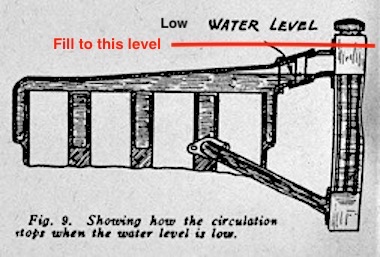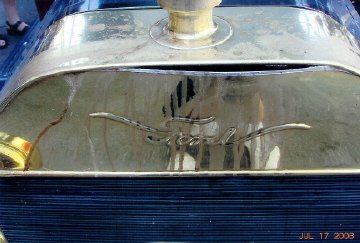Page 1 of 1
Motometer reading
Posted: Sun Feb 02, 2025 1:03 pm
by popeyet
Is the optimum engine running temperature when the motometer reads near the mid-line?...
Re: Motometer reading
Posted: Sun Feb 02, 2025 2:55 pm
by Humblej
Just at or under the circle.
Re: Motometer reading
Posted: Sun Feb 02, 2025 6:40 pm
by Allan
A motometer doesn't really meter anything. It is an indicator which can indicate when things are hot. There is likely a difference in levels between different instruments on the same car. Just take what is shows you as an indication of what is going on, and take action if anything varies from the usual for your car.
Allan from down under.
Re: Motometer reading
Posted: Sun Feb 02, 2025 7:39 pm
by popeyet
I ask the question because I've been trying to improve the winter driving capabilities of my car. My motometer was not registering the slightest "red" in the thermometer. Then I installed a "winter front" advertising cover much like I found was used in the past. It helped to bring up the "red" but still not up to the mid-line mark.
So I was wondering how hard I might try to get it up in temperature so the engine will run as best as possible? I know in the summer my car runs pretty much near the mid-line.
It was about 35 degrees for this test.
Re: Motometer reading
Posted: Sun Feb 02, 2025 8:59 pm
by Norman Kling
It will vary by the make of the motometer. Also the driving conditions such as the temperature of the atmosphere and the steepness of the grade. Also whether driving into a headwind or tail wind. And of course the condition of the radiator and cleanness of the block. An important thing to note, however if it goes above the circle, stop and let the engine cool off. If it goes up too high, it will be impossible to get it down again. And r the engine gets too hot it will seize up causing damage to the cylinders and or crankshaft and pistons. So the important thing to do if it goes up very high, to let it cool off before adding coolant. Also look for leaks or reasons for overheating. Sometimes the leak can be very small and if you check the night before going on a tour and loading it on a trailer and parking it overnight for departure on the tour next day, you will be over 24 hours since you checked the fluid level. A very small leak in that amount of time might lower the level so that you will overheat. So when the engine is cold, check the level before starting to drive. The fluid should be about half way up the top tank when cold. About the level of the Ford name on the radiator.It is also good to check it after you stop for lunch or other period to see if it still has enough coolant.
Norm
Re: Motometer reading
Posted: Sun Feb 02, 2025 10:28 pm
by MarkS
“About the level of the Ford name on the radiator”.
Always been confused by this statement. Bottom, middle or top of the Ford script?
Re: Motometer reading
Posted: Mon Feb 03, 2025 10:12 pm
by Wayne Sheldon
"Motometer" is a name. What one is supposed to do (not being snarky, just what was originally expected?) is have a Motometer you like on the car you have and drive, and become familiar with it. One should get to know what to expect under various normal conditions. Motometers vary considerably, and cars also vary from one to another. However, there are some usual parameters for both. On anything other than really cold days, the "red" should at least show itself. Some meters will actually show red when cold on any day with temperatures above about 50 d F. Others need to run for a short while before the red will show. Some era cars will tend to run with coolant temperatures in the mid 100 range, other cars seem to want to run near or even above 200 d F.
One should learn what to expect in your car with your meter (sometimes a problem for people that like to collect caps and meters and use a different one every time they go for a drive?). Realize, that sometimes a low reading might mean your water is low, and may be heading for trouble? When the water is low, but not low enough to stop circulating, the air in the top of the radiator might actually be lower enough for the meter to show it low.
Sometimes, when the water gets low enough to nearly stop circulating, and making the air inside really hot? Sometimes one does not get much warning.
I love my Motometers! Even though I usually run my brass era Ts without one. Boyce went on the market with the Motometer about 1912, but they did not become common on model TS until a few years later.
Re: Motometer reading
Posted: Tue Feb 04, 2025 12:09 am
by popeyet
Thank you all for your replies. It does seem that I will us it as my reference indicator, and the good news is that I have done a few things now that lets me drive on a cold day here in the Northwest winter. It was running very cold and the carb was coughing but now it's running very acceptably.
Chris.
I want anyone trying to drive in the cold to know that the vintage style cardboard "winter front" cover made a remarkable difference in bringing the engine up to temp. Without it the fan was blowing harsh, wintery cold air into the engine and it ran terrible. I didn't have a vintage one, but I thought the "Louisville Slugger" slogan was pretty cool.
Re: Motometer reading
Posted: Tue Feb 04, 2025 11:24 am
by RajoRacer
Are you running with a hot-air pipe ? Makes a difference !
Re: Motometer reading
Posted: Tue Feb 04, 2025 12:30 pm
by Jerry VanOoteghem
This is why I don't use moto meters...
Re: Motometer reading
Posted: Tue Feb 04, 2025 12:32 pm
by Jerry VanOoteghem
MarkS wrote: ↑Sun Feb 02, 2025 10:28 pm
“About the level of the Ford name on the radiator”.
Always been confused by this statement. Bottom, middle or top of the Ford script?
The answer is "yes".
In other words, it's not that critical. If you put in too much, the overflow tube will simply dump out the excess for you.
Of course, too little can be an issue.
Re: Motometer reading
Posted: Tue Feb 04, 2025 12:43 pm
by popeyet
Steve, thanks for mentioning that. Yes, I started with a heat pipe. Then I fabricated what I call a "heat collector" to help and to protect the intake manifold from the icy air that was being blown through the engine compartment. I was getting condensation just above the carb.
I have an intermediately built engine and run a Winfield V4 carb, with water pump and now a 180 deg thermostat. I know all the "stock" guys will shudder, but I've already had and experienced a stock car (1921 touring - very fun and nice). But I have worked very hard on this little roadster and have made suspension improvements, upgraded to wire wheels, and added other things like the '14 rear fenders to make it look and be what I wanted.
Re: Motometer reading
Posted: Tue Feb 04, 2025 1:19 pm
by Steve Jelf
I drive on country roads a lot. They are not always smooth. Not wanting extra weight bouncing on top of my radiator neck, I use this. It works for me.
Re: Motometer reading
Posted: Tue Feb 04, 2025 1:22 pm
by popeyet
I only put the motometer on to see what is going on at the time. Mostly I run the small cap to reduce the stress on the radiator neck.
Re: Motometer reading
Posted: Wed Feb 05, 2025 9:43 am
by TXGOAT2
If you operate in cool damp weather, or just very damp weather, a heat pipe of some sort will improve performance and drive-ability.
My car does not have one, and it runs better on days with low humidity, which eliminates intake condensation or frost. Idle is smoother and throttle response is better. Ideally, you'd have a heat pipe arrangement with a dash control to adjust it as needed, from no heat to full heat.
Re: Motometer reading
Posted: Wed Feb 05, 2025 11:07 am
by TRDxB2
A Moto-Meter reads the temperature of the water VAPOR in the radiator. The end of temperature probe is in the upper potion of the filler neck. You need to consider the affect of the wings in cooling the area being read and if you are using antifreeze.
The most efficient engine operating temperature has been noted as 180-190 degrees Fahrenheit
Re: Motometer reading
Posted: Wed Feb 05, 2025 12:37 pm
by DanTreace
Frank
Thanks for posting that Ford manual answer on the cooling system, it clearly states to keep the coolant level "
above the level of the upper hose connection " to keep the syphon working, like any syphon hose, once the hose allows air with a low level of fluid, the syphon will stop.
Then the coolant will stay in the engine block and keep heating until steaming occurs, and over heating by boiling is the result.
Check you radiator coolant level before every adventure out in your T for safety of your motor.

- Low coolant level.JPG (52.7 KiB) Viewed 5956 times
Re: Motometer reading
Posted: Wed Feb 05, 2025 3:28 pm
by J1MGOLDEN
If you fill the radiator full for a hot day tour, and the overflow is even a little bit plugged.
The radiator will look like this of the air temperature is 98 degrees.

- Top View.jpg (22.66 KiB) Viewed 5925 times
Re: Motometer reading
Posted: Wed Feb 05, 2025 6:05 pm
by DanTreace
James
Yikes! That isn't good 
To again answer the question “About the level of the Ford name on the radiator” did a measure in the garage just now on two Ts, high radiator and brass radiator.
For FL, the coolant level best is above the core, and above the splash plate a bit.
So used a stick placed in the radiator, down to the top surface of the coolant, and used the very TOP RIM of the radiator neck as the measuring point.
High radiator
Brass radiator
Removed the measure stick from each, and then laid the stick over the face of the radiator, again the end of the stick at the top rim of the neck. Both laid right across the Ford Script, so that is the answer to the question. If you do fill a little more above the splash plate, the excess will be barfed out.